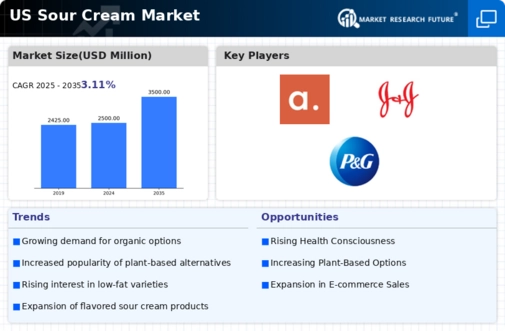Expansion of Retail Channels
The sour cream market is witnessing an expansion of retail channels, which is facilitating greater accessibility for consumers. With the rise of e-commerce and online grocery shopping, consumers can now easily purchase sour cream products from the comfort of their homes. Additionally, traditional retail outlets are enhancing their dairy sections, offering a wider variety of sour cream options, including organic and specialty varieties. Recent statistics show that online grocery sales have increased by 20% in the last year, indicating a shift in consumer purchasing behavior. This expansion of retail channels is likely to enhance the visibility and availability of sour cream products, thereby driving growth in the sour cream market.
Innovations in Product Offerings
The sour cream market is experiencing a wave of innovations in product offerings, as manufacturers strive to meet evolving consumer preferences. This includes the introduction of low-fat, lactose-free, and flavored sour cream options, catering to health-conscious consumers and those with dietary restrictions. Recent market analysis suggests that flavored sour cream products have seen a growth rate of approximately 5% over the past year, indicating a strong consumer interest in diverse flavor profiles. These innovations not only attract new customers but also encourage existing consumers to experiment with sour cream in various culinary applications. As the industry continues to innovate, it is likely to see sustained growth and increased market share.
Growing Demand for Dairy Products
The sour cream market is experiencing a notable increase in demand for dairy products, driven by a resurgence in consumer interest in traditional dairy items. This trend is partly attributed to the rising popularity of cooking shows and culinary influencers who emphasize the use of sour cream in various recipes. According to recent data, the dairy sector has seen a growth rate of approximately 3.5% annually, with sour cream being a key contributor. As consumers seek to enhance flavors in their meals, the versatility of sour cream in dips, dressings, and baked goods positions it favorably within the market. This growing demand for dairy products is likely to bolster the sour cream market, as manufacturers respond by innovating and expanding their product lines to meet consumer preferences.
Rising Popularity of Ethnic Cuisine
The sour cream market is benefiting from the rising popularity of ethnic cuisine, particularly Mexican and Eastern European dishes that prominently feature sour cream. As consumers become more adventurous in their culinary choices, they are increasingly incorporating sour cream into their cooking, enhancing the authenticity of their meals. Market data indicates that sales of sour cream have increased by approximately 6% in regions where ethnic cuisine is particularly popular. This trend not only boosts the demand for traditional sour cream but also encourages manufacturers to explore new flavor combinations and product variations. The growing interest in ethnic cuisine is likely to further propel the sour cream market, as it aligns with consumers' desires for diverse and flavorful dining experiences.
Increased Focus on Culinary Experiences
The sour cream market is benefiting from a heightened focus on culinary experiences among consumers. As dining out becomes a more cherished activity, individuals are increasingly seeking to replicate restaurant-quality dishes at home. This trend has led to a surge in the use of sour cream as a key ingredient in gourmet recipes, enhancing flavors and textures. Market data indicates that the premium segment of sour cream products has grown by approximately 4% in the past year, reflecting consumers' willingness to invest in higher-quality ingredients. This shift towards culinary exploration is likely to drive further growth in the sour cream market, as brands introduce innovative flavors and packaging to cater to adventurous home cooks.














Leave a Comment